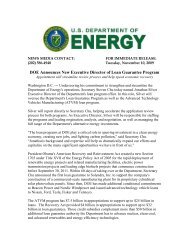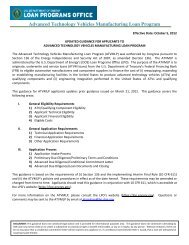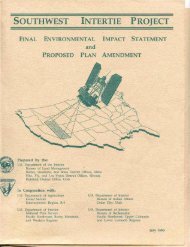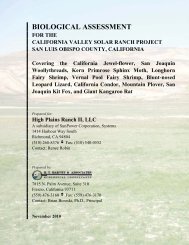Bureau of Land Management's Decision Record and Environmental
Bureau of Land Management's Decision Record and Environmental
Bureau of Land Management's Decision Record and Environmental
Create successful ePaper yourself
Turn your PDF publications into a flip-book with our unique Google optimized e-Paper software.
Jersey Valley Geothermal Development Project<br />
<strong>Environmental</strong> Assessment: NV063-EAO8-091<br />
water movement is transmitted mostly through unconsolidated sediments in the valley floor <strong>and</strong>,<br />
to a lesser extent, through localized areas <strong>of</strong> highly fractured consolidated rocks. Ground water<br />
from the Jersey Valley basin eventually flows to the southwest <strong>and</strong> contributes to the Dixie<br />
Valley Hydrographic Area ground water basin recharge.<br />
The Jersey Valley Hydrographic Area has committed ground water rights <strong>of</strong> 27.25 AFY <strong>and</strong> an<br />
estimated perennial yield <strong>of</strong> 250 AFY. The manner <strong>of</strong> use for all <strong>of</strong> the committed ground water<br />
rights is reported as industrial (NDCNR-DWR 2009a). The point <strong>of</strong> diversion for this ground<br />
water use is located within the privately owned l<strong>and</strong> block within the JV Unit Area in the<br />
NW¼SW¼ <strong>of</strong> Section 34, T27N, R4OE (see Figure 6). The application for this ground water<br />
right was filed on March 25, 2009 (NDCNR-DWR 2009b). As <strong>of</strong> January 2010, the<br />
NDCNR-DWR had no well drill log records available for this ground water diversion point<br />
(NDCNR-DWR 201 Oc).<br />
There is one recorded ground water well located within five miles <strong>of</strong> the Jersey Valley hot<br />
springs. This well, currently owned by the BLM, is located in the Jersey Valley Hydrographic<br />
Area, approximately 4 miles southwest <strong>of</strong> the Jersey Valley unit area, in the SE¼, SW¼ <strong>of</strong><br />
Section 11, T26N, R39E (see Figure 6). The well was constructed in 1957 to a total depth <strong>of</strong><br />
200 feet with a reported depth to ground water <strong>of</strong> 138 feet (NDCNR-DWR 2010c). Subsequent<br />
measurements <strong>of</strong> the depth to ground water in this well, taken during 1981 <strong>and</strong> 1982, show a<br />
consistent depth to ground water <strong>of</strong> 136 feet (USGS 2009b). The USGS has no available ground<br />
water quality data from this well (USGS 2009c).<br />
Between 1981 <strong>and</strong> 1982, fourteen geothermal exploration (temperature gradient) “wells” were<br />
drilled within five miles <strong>of</strong> the Jersey Valley unit area. Of these, nine are located within the<br />
Jersey Valley unit area (NDCNR-DWR 2010c). All <strong>of</strong> these geothermal exploration “wells”<br />
were drilled to relatively shallow depths (ranging from 340 feet to 500 feet). The NDWR does<br />
not list these wells as plugged <strong>and</strong> ab<strong>and</strong>oned, although the drilling logs on file indicate that they<br />
were sealed with cement upon completion. No depth-to-ground water measurements or water<br />
quality data are available for any <strong>of</strong> these geothermal exploration “wells” (NDNR-DWR 2OlOc).<br />
Surface water within the Jersey Valley unit area is limited to a few springs <strong>and</strong> associated ponds<br />
<strong>and</strong> a few west-flowing stream channels. Figure 6 shows streams flowing out <strong>of</strong> Jersey Canyon,<br />
Butcher Canyon <strong>and</strong> several unnamed canyons within the unit area. These streams are either<br />
ephemeral (flowing only during or immediately after rain events) or intermittent (flowing part <strong>of</strong><br />
the year, principally due to rain events <strong>and</strong> spring snowmelt, but dry the rest <strong>of</strong> the year). No<br />
stream flow or water quality data are available for these streams.<br />
Figure 6 also shows five springs within the Jersey Valley unit area. The eastcrnmost spring is a<br />
cold water spring located at the mouth <strong>of</strong> Jersey Canyon on private l<strong>and</strong> within the Jersey Valley<br />
unit area in the NW¼SW¼ <strong>of</strong> Section 34. The northernmost spring, located in Section 15, <strong>and</strong><br />
the westernmost spring, located in the center <strong>of</strong> Section 29, are both small hot springs/seeps with<br />
little flow.<br />
- 65 -







